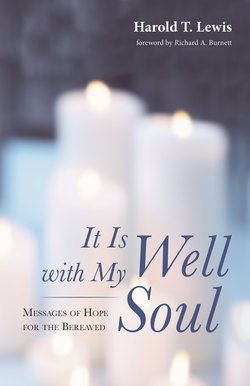Читать книгу It Is Well with My Soul - Harold T. Lewis - Страница 6
На сайте Литреса книга снята с продажи.
Foreword
ОглавлениеThis is truly a mysterious book.
No, not in the sense of an Agatha Christie whodunit. Nor is it like a dense, jargon-riddled tome intended only for theologians. The mystery found in this book is the central claim of Christian living: the Paschal Mystery, “a cycle of rebirth,” as Ronald Rolheiser says in his modern classic, The Holy Longing. It is “an invitation to live into the kingdom and reign of God . . . to see differently,” in the words of liturgist Susan Marie Smith. In this collection of sermons (along with its extensive introduction), Harold Lewis unravels, in his own way, the Paschal Mystery and, in so doing, provides us with many lenses for clearer understanding of and more profound insights into the mystery of the life of Christ, which Jesus himself shared with his friends in those first peripatetic homilies offered throughout the Galilean countryside.
In the pages of It Is Well with My Soul, we meet over and over the Apostle Paul, who tells the Christians at Rome, “If we have died with Christ, we believe we shall also live with him” (Rom 6:8). For Lewis, Christian preaching should never be absent from Christian burial. Indeed, Dr. Lewis would have gotten along famously with a visiting professor of liturgics who proclaimed: “If the Christian church cannot speak at the time of death, it cannot speak at all.” In these pages, too, we encounter not only Lewis the preacher and teacher but also Lewis the racial reconciler, Lewis the historian, and Lewis the pastor. For only the pastor can admonish his seminary flock: “Thou shalt not bleed on your congregation”—which I have always taken to mean that, in vague or clumsy attempts to seek the heights of what is often called narrative preaching, we must be careful not to confuse the subject of all preaching, Christ and Him crucified, with ourselves! As Paul reminds us, we must preach “not ourselves but Jesus Christ as Lord and ourselves as your servants for Jesus’ sake” (2 Cor 4:5).
Harold Lewis, a devoted son of the Anglo-Catholic expression of Anglicanism, understands the role of liturgical preaching too well to expect the sermon to stand alone in the Burial Rite. For him, the sermon gives voice to the many other voices in prayer and recollection, grief and thanksgiving, humor and confession, and joyful songs raised to the Lord Jesus who, by his love alone, receives the departed “upon another shore and in a greater light.” The Paschal Mystery is the heart of all Christian proclamation, and in this book we are given, even now, glimpses of “the blessing granted us through the prayers of many.”
In these funeral sermons, preached at the memorial liturgies of the famous and not-so-famous over the past three decades, Dr. Lewis offers brave witness to the Resurrection and insights into the greatest mysteries we share as the Body of Christ. But whether preaching to the diocesan family of a bishop taken away from them in his one hundredth year, or to the parents, siblings, and friends of a young man who took his own life at thirty, Lewis—a man who has been a leader in Christian social witness and has lived at the center of the Episcopal Church’s dynamic engagement in the world—sounds the clarion call of sure and certain hope with characteristic wit and wisdom. Thus inspired, the bereaved may leave worship proclaiming in their hearts and on their lips: “It is well with my soul.”
Richard A. Burnett
Trinity Episcopal Church, Columbus, Ohio
